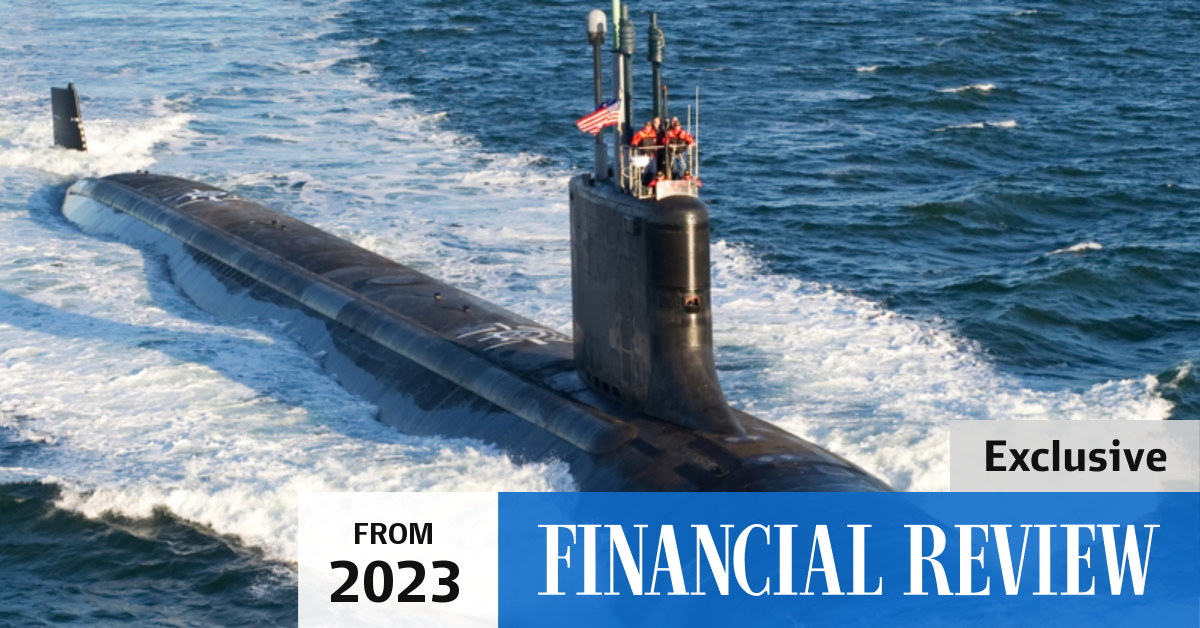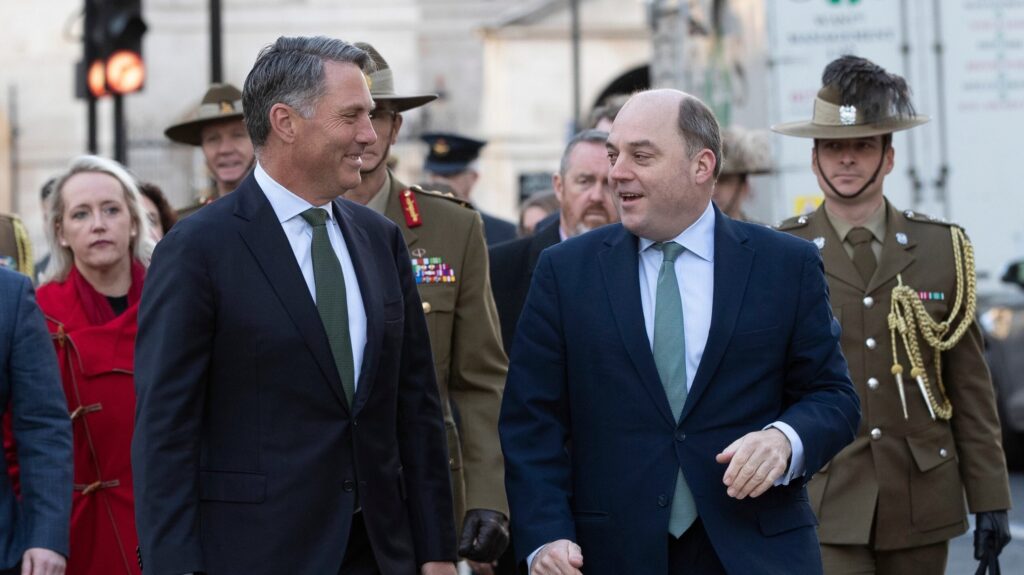Of course Canada is outside the fence

The Anglophone military alliance in Asia is seriously ambitious
America, Australia and Britain will build, man and arm each other’s nuclear subs in Asia
IN 1908 the second USS Missouri, an American battleship, sailed from San Francisco to Sydney, part of the so-called Great White Fleet’s tour of Asia and circumnavigation of the world. Her successor, the third USS Missouri, hosted Japan’s surrender in 1945. On March 13th the fourth USS Missouri, a Virginia-class attack submarine, lived up to this illustrious lineage by etching her own name in the history of American naval power in the Pacific.
On a warm afternoon in San Diego, Joe Biden, Anthony Albanese and Rishi Sunak, leaders of America, Australia and Britain, gathered in front of the Missouri and revealed the next chapter of the
AUKUS pact signed by their countries 18 months ago. The resulting agreement will intensify American and British involvement in the Pacific and bind the three allies together in unprecedented ways, into the 2040s and beyond.
This saga began in 2016 when Australia agreed a $33bn-deal to replace its ageing Collins-class attack submarines with a dozen French diesel-electric boats. In 2021, increasingly mindful of the threat from China, it tore up that deal and signed AUKUS with great fanfare. Under its terms, America and Britain would help Australia build a fleet of at least eight nuclear-powered (though not nuclear-armed) submarines. These have far greater range, endurance and stealth than electric boats (see map). They are also far more complex. Only six countries have them and America has until now only shared the technology with Britain.
Many expected that Australia’s future submarine would be modelled on America’s current Virginia-class sub or on its planned successor. Yet Mr Biden, Mr Albanese and Mr Sunak revealed that it will in fact be based on Britain’s future attack sub, a hypothetical boat known as the SSNR (“SSNs” are attack submarines, which carry conventional weapons and hunt other subs and ships, as opposed to “SSBNs”, which carry nuclear-armed ballistic missiles). Britain will build the first boats at Barrow in north-west England. Australia will learn from the prototypes and then build its own in Adelaide. The idea is to create an economy of scale, with Australian investment boosting British shipbuilding capacity and a larger aggregate order lowering the cost to both countries.
American technology will suffuse this new “SSN-AUKUS”. America will provide its vertical launching system, a set of tubes that can hold a greater number of missiles, and more advanced ones, than traditional torpedo tubes. No British attack submarine has had this capability. The defence industries of all three countries will be entangled to an unprecedented degree. Subsystems like communications gear, sonar and fire control should be compatible between the Anglo-Australian boat and the next American one. “We’ll almost be one joint nuclear submarine force”, says one official involved in the pact. It will be a “beautiful, blended submarine” gushes another.
But, like that of whisky, the production of high-end subs is measured in double-digit years. Australia’s current boats are around 30 years old and will need to be retired by the early 2030s. The first SSN-AUKUS will not be in Australia’s hands until the early 2040s. It takes at least 15 years to produce a submarine commanding officer in America’s navy, says Tom Shugart, who reached that position himself—partly because of the complexity of training officers how to use and maintain nuclear propulsion systems. China’s navy, already the largest in the world, looks dangerous. To bridge the gap, the three leaders announced two further path-breaking steps.
First, as early as 2027, America and Britain will deploy their own subs to the Pacific in a scheme that some officials are calling “enhanced rotational presence”, a deliberate nod to NATO’s “enhanced forward presence” of armoured battle groups in eastern Europe. America typically has two-to-four attack subs in Asia at any time, according to one official. Under the new set-up it will rotate up to four Virginia-class subs to hmas Stirling near Perth—a big and relatively conspicuous step that will require ending a longstanding policy of near-total secrecy about sub deployment. Britain plans to rotate one of its own Astute class subs, out of a planned fleet of only seven. Australian sailors have already started embedding in American and British subs.
Second, in the early 2030s, and assuming Congress approves, Australia will buy three Virginia-class submarines from America at a discounted rate, with the option of two more, as an interim boat to use until ssn-aukus turns up. That America agreed to this is surprising. Renting out a nuclear sub is vanishingly rare: only Russia has ever done it, to India. Australia has struggled to crew its current subs, which take fewer than 60 people; the Virginia-class needs 140 or so. More important, America’s navy is still struggling to churn out enough Virginia-class subs for itself as it races to close the gap with China. To ease that problem, Australia is expected to invest billions of dollars in American shipyards. Even then, many in Congress may be unhappy with the diversion of hulls. And America’s lawmakers may need to amend the International Traffic in Arms Regulations (ITAR), which imposes strict limits on high-tech exports even to close allies.
The risks are manifold. The project will need to endure at least three American presidential terms beyond Mr Biden’s current one and more than three British elections, a stiff test, even if it currently has bipartisan support in all three countries. The cost to Australia could be $180bn-245bn over the next 32 years, including $6bn in the next two years, according to very early estimates. For Australia to produce the necessary skilled labour and nuclear expertise will be formidable. “This is potentially a 100-year endeavour,” observed Peter Malinauskas, the premier of South Australia, of which Adelaide is the capital, on March 10th.
But the pay-off will be high. For Britain, the benefit is not just a shot in the arm for a submarine industry that has struggled with stop-start construction. It also gives real substance to the government’s wished-for “tilt” to the Indo-Pacific. Critics had questioned the wisdom of emphasising naval power in Asia while a land war raged in Europe; Mr Sunak has doubled down. On March 10th he agreed with Emmanuel Macron, France’s president, that the two countries would establish “the backbone to a permanent European maritime presence in the Indo-Pacific” by co-ordinating deployments of their aircraft-carriers. On March 13th Mr Sunak’s government published a mini-review of foreign policy which emphasised the “epoch-defining” challenge from China. The decision to rotate subs through Asia and co-build new ones with an Asian ally gives the tilt an additional long-term anchor.
For America, aukus and the related agreements are the latest and most dramatic step in its steady consolidation of Asian alliances. It is likely to sell hundreds of cruise missiles to Japan and in January agreed to place a marine regiment in Okinawa. In February it secured access to four extra military bases in the Philippines. AUKUS also includes a second “pillar” of collaboration on advanced technologies such as artificial intelligence, quantum systems and hypersonic missiles. And it is part of a wider boom in US-Australian defence ties.
America has invested huge sums in building up stockpiles of fuel and ammunition in Australia and expanded airfields to allow long-range bombers to operate from the north of the country, out of the range of most Chinese missiles. Australian investment in naval bases around Perth to support the rotational deployments of American and British subs will make it easier for the boats to be maintained, repaired and replenished without having to slog back to Guam or Hawaii, enabling a higher tempo of operations in peacetime and war.
The fact that AUKUS survived the transition from Australia’s centre-right Liberal party to Mr Albanese’s centre-left Labour party last year reflects the consensus now baked into Australian politics over the threat from China and the need for drastic measures to confront it. A defence review in 2020 concluded that the prospect of a major war was “less remote than in the past” and that the government could no longer be assured of a ten-year warning of its impending outbreak. (A new defence review written by a former defence minister and military chief was submitted to the government in February but has not yet been published.)
At present Australia cannot strike a target or protect an expeditionary force more than about 150km from its landmass, points out Ashley Townshend, an Australian expert at the Carnegie Endowment, a think-tank in Washington. Its new subs, he says, will give it “escalation options” in regional crises where Australian leaders might want to “deter or defeat” a Chinese military presence—say, in South-East Asia or in the Southern Pacific—but lack confidence to do so without the cover of a mobile strike force. “This will be an Australian sovereign capability,” emphasised Mr Albanese, “built by Australians, commanded by the Royal Australian Navy and sustained by Australian workers in Australian shipyards”.
But the the scenario that weighs most heavily on American planners is a larger war over Taiwan. “aukus has one overriding objective:” declared Mr Biden, in front of the Missouri, “to enhance the stability of the Indo-Pacific amid rapidly-shifting global dynamics.” A US-Australian pact in 2021 spelt out, more explicitly, the purpose of all that investment in Australian facilities: “to support high-end warfighting and combined military operations in the region”. Eight additional subs’ worth of missiles prowling in the South and East China Seas would make it significantly harder for China to get an invasion force across the Taiwan strait.
That will add to deterrence. Equally significant, it has developed the Anglophone military alliance in Asia to a point of no-return. Australia’s ports, bases and potentially submarines will increasingly be baked into American war plans. That gives Australia influence and leverage over those plans, says Mr Townshend. It also constrains its options. “This is an extremely costly signal of our willingness to contribute to the collective deterrence of China. To back out of it would cause an unimaginable rift in the alliance—which is precisely why it will be taken seriously in Beijing.”■
America, Australia and Britain will build, man and arm each other’s nuclear subs in Asia

www.economist.com

 www.afr.com
www.afr.com






